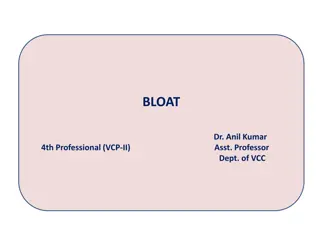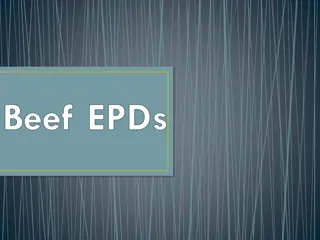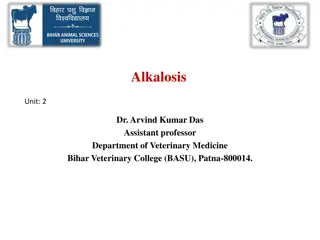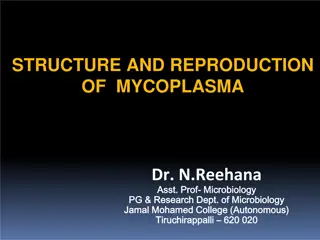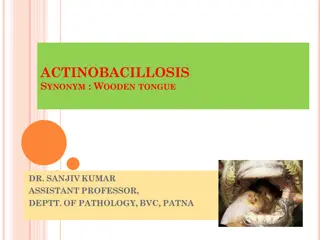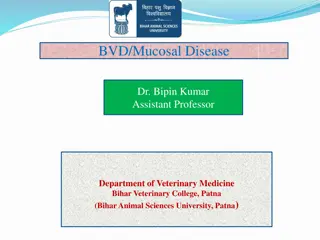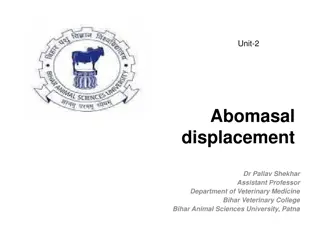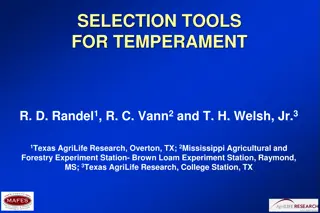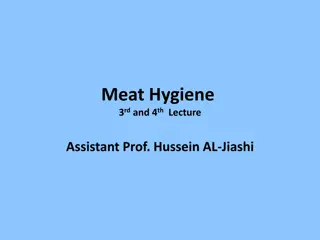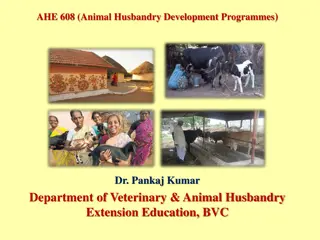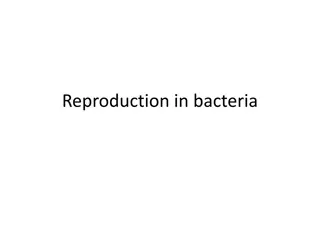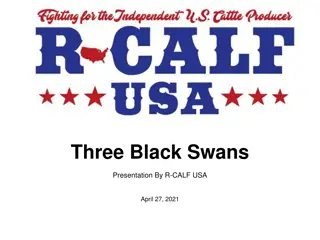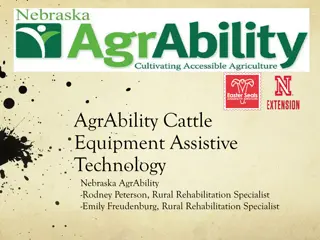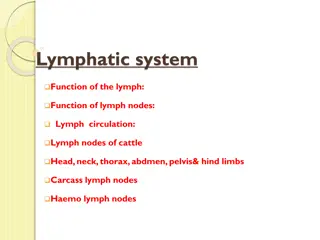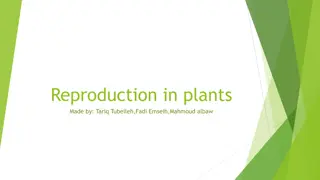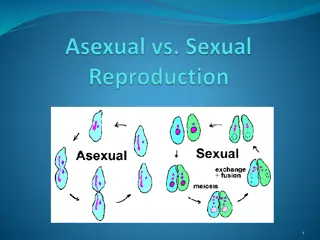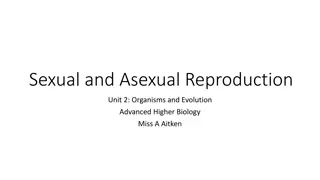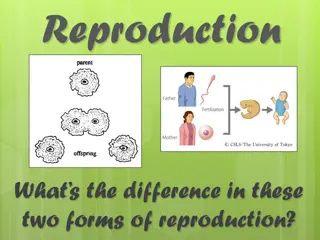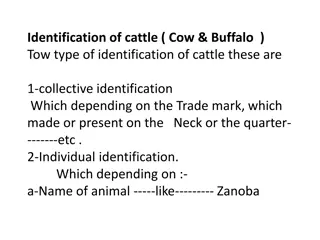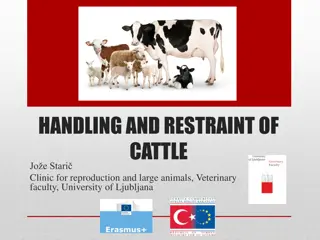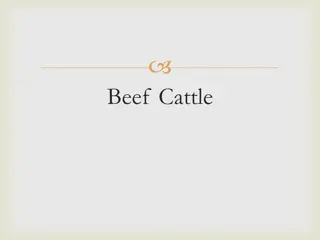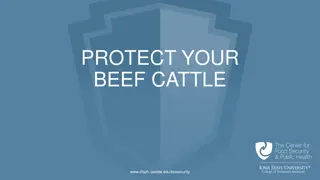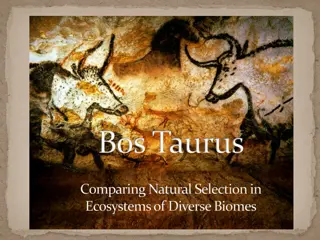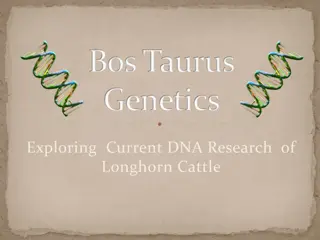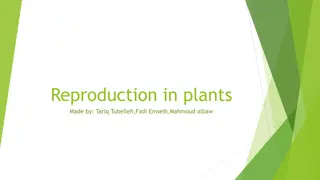Understanding Bloat in Cattle: Causes, Symptoms, and Treatment
Bloat in cattle, characterized by overdistension of the rumenoreticulum with gases of fermentation, can be caused by various factors including diet, obstruction, or diseases. Frothy bloat and free gas bloat are common types, each with its own triggers and symptoms. Diagnosis involves a thorough hist
1 views • 8 slides
Understanding Expected Progeny Differences (EPDs) in Beef Cattle Selection
Expected Progeny Differences (EPDs) in beef cattle breeding predict future offspring performance based on genetic merit. They help compare animals as parents and aid in selecting for traits like birth weight, weaning weight, and yearling weight. Combining EPDs with visual appraisal improves decision
0 views • 15 slides
Livestock Breeding Policy for Genetic Improvement of Cattle and Buffalo in India
India's diverse agro-ecological regions host a wide range of farm animal breeds. The livestock breeding policy aims to enhance the productivity of cattle and buffalo through strategies such as grading up with indigenous superior dairy breeds, crossbreeding with high-yielding exotic breeds, and selec
1 views • 23 slides
Understanding Alkalosis in Cattle: Causes and Pathophysiology
Alkalosis in cattle, particularly ruminal alkalosis, can be caused by issues such as abomasal atony and alkaline indigestion. Excessive intake of protein-rich feed and changes in diet play a significant role. Pathophysiology involves the accumulation of ruminal ammonia, leading to alkaline pH and ru
1 views • 13 slides
Mycoplasma: Structure, Reproduction, and Characteristics
Detailed exploration of Mycoplasma covering its structure, reproduction, and general characteristics. Discusses the ultrastructure, species like Mycoplasma pneumonia and Mycoplasma hominis, and their unique traits such as lack of cell wall, pleomorphism, and reproduction methods. The article also to
0 views • 14 slides
Actinobacillosis (Wooden Tongue) in Cattle and Sheep: Overview of the Infectious Disease
Actinobacillosis, also known as Wooden Tongue, is a specific infectious disease affecting cattle and sheep, caused by Actinobacillus lignieresii. It is characterized by fibrosis of the tongue and soft tissues, leading to mobility issues. The disease is primarily transmitted through wounds and abrasi
0 views • 8 slides
Reproduction in Organisms: Overview and Types
Understanding the concept of reproduction in organisms, this content delves into the different modes of reproduction such as asexual and sexual, with examples and illustrations. It covers the life spans of various organisms and details various methods of asexual reproduction like fission, budding, s
0 views • 23 slides
Understanding Bovine Virus Diarrhea and Mucosal Disease in Cattle
Bovine Virus Diarrhea (BVD) and Mucosal Disease (MD) are two clinically distinct yet interconnected syndromes in cattle caused by Pestivirus. While originally thought to be separate, they share a common viral etiology. BVD can lead to persistent infections, while MD is sporadic, progressive, and fat
0 views • 14 slides
Understanding Abomasal Displacement in Dairy Cattle: Causes, Symptoms, and Management
Abomasal displacement is a common issue in older lactating dairy cattle, often related to inadequate nutrition and concurrent diseases. This condition involves the displacement of the abomasum from its normal position, causing symptoms like anorexia, ketosis, and dehydration. Learn about the causes,
1 views • 21 slides
General Characteristics of Phycomycetes in Fungi Classes
Fungi are classified into four classes based on hyphae, spores, and reproduction methods. Phycomycetes, as an algal-like fungi class, showcase varied forms with reproduction mainly through sexual or asexual means. The thallus structure varies from one-celled to well-branched mycelium, and reproducti
0 views • 22 slides
Understanding Different Types of Reproduction in Organisms
Unwanted materials can be passed directly or indirectly, impacting the complexity of systems and bodies. Reproduction methods include sexual and asexual, each with unique processes and characteristics. Asexual reproduction involves division and growth, while sexual reproduction combines hereditary i
1 views • 105 slides
Understanding Sand Crack in Cattle Hooves: Causes, Signs, and Treatment
Sand crack, a fissure of the horny wall in cattle hooves, can present transversely or longitudinally. It commonly affects dairy breeds and is predisposed by various factors such as overgrowth of digital horn and chronic laminitis. Diagnosis and treatment differ based on the form of the crack, with s
0 views • 10 slides
Understanding Cattle Temperament: Implications for Producers
Cattle temperament plays a crucial role in the overall well-being of livestock and can impact factors such as stress levels, growth rates, and immune function. This article delves into the importance of evaluating and managing temperament in cattle to mitigate risks of injury, reduce stress-related
2 views • 32 slides
Common Infective Diseases in Cattle and Their Implications
Infective diseases such as blackquarter, brucellosis, and foot and mouth disease pose significant threats to cattle health and food safety. Blackquarter is a fatal disease caused by Clostridium chauvaei, while brucellosis leads to contagious abortion in cattle. Foot and mouth disease is highly conta
0 views • 17 slides
Dairy Cattle Production Systems in Ethiopia: Overview and Practices
Ethiopia has a favorable environment for dairy development with diverse production systems including pastoralism, agro-pastoralism, and mixed farming. The country boasts indigenous and exotic dairy cattle breeds, supporting milk production and utilization. This article outlines the different dairy p
2 views • 38 slides
Animal Husbandry Development Initiatives in India: Gaushalas and Gosadans
Animal Husbandry Development Programmes in India have a rich history dating back thousands of years, with initiatives like Gaushalas and Gosadans playing a significant role in preserving indigenous cattle breeds, promoting milk production, and supporting rural economies. Gaushalas aim to breed and u
0 views • 10 slides
Understanding Bacterial Reproduction: A Comprehensive Overview
Explore the various types of reproduction in bacteria, including asexual reproduction through binary fission, as well as the intricate process of endospore formation for survival in harsh conditions. Discover how bacterial cells exchange genetic material in sexual reproduction through conjugation, t
0 views • 19 slides
History and Vocabulary of Cattle Farming
Explore the rich history of cattle farming, from the introduction of longhorn cattle in America by the Spanish to the importation of European dairy cattle to Jamestown Colony. Learn about various terms and concepts associated with cattle, such as castration, heifer, marbling, and more. Delve into th
0 views • 36 slides
Addressing Challenges in the Cattle Market: A Call to Action
Explore the concept of Black Swan events in the cattle market and how they can affect market dynamics negatively. The presentation by R-CALF USA delves into instances where markets respond counter to fundamentals and overreact to minor stimuli. Issues such as high captive supply levels and import sp
0 views • 12 slides
Enhancing Cattle Farming with Assistive Technology in Nebraska
Nebraska AgrAbility specialists, Rodney Peterson and Emily Freudenburg, discuss the impact of modern equipment on cattle farmers with disabilities. They highlight the evolution of technology in cattle farming, introduce a new hydraulic feed box for efficient feeding, and provide vendor contact infor
0 views • 25 slides
Understanding Cattle Management and Classification
Cattle, belonging to the genus Bos, are classified into three types - Bos Taurus, Bos Indicus, and Bos Africans. They are ruminants with fixed hollow horns, udders with four teats, and males have teats on the scrotum. Cattle are utilized for milk production, agriculture, and meat manufacturing. They
0 views • 70 slides
Understanding Reproduction in Living Organisms
Reproduction in living organisms involves both sexual and asexual methods, with each having unique processes. Sexual reproduction involves the fusion of genetic material from two individuals, while asexual reproduction results in genetically identical offspring. Different forms of plant reproduction
0 views • 14 slides
Understanding Reproductive Modes: Asexual vs. Sexual
Reproduction can occur through asexual or sexual means, each with its distinct processes and outcomes. Asexual reproduction involves only one parent and produces genetically identical offspring, while sexual reproduction involves the fusion of specialized sex cells from two parents to create genetic
1 views • 46 slides
Feasibility Study: Measuring Ruminal Contractions of Cattle Using an Inexpensive Electronic Veterinary Stethoscope
Effects of gastrointestinal motility in understanding disease and nutrition in cattle are actively researched. This study explores monitoring ruminal contractions using a cost-effective electronic stethoscope. The device, developed with Arduino technology, showed promising results in capturing inter
0 views • 35 slides
Understanding the Lymphatic System in Cattle: Nodes, Circulation, and Function
The lymphatic system in cattle plays a crucial role in maintaining overall health. It consists of lymph nodes located in various regions of the body such as the head, neck, abdomen, and hind limbs. These lymph nodes produce lymphocytes and help in filtering foreign bodies. Lymph fluid, similar to bl
0 views • 39 slides
Reproduction Methods: Asexual vs. Sexual Reproduction in Organisms
Asexual and sexual reproduction are two fundamental methods in nature, with asexual reproduction producing genetically identical offspring and sexual reproduction resulting in genetic variation. Asexual methods include fission, budding, fragmentation, and parthenogenesis, while sexual reproduction i
1 views • 6 slides
Understanding Reproduction in Plants: Types, Processes, and Examples
Reproduction in plants involves both sexual and asexual methods, each with distinct processes and outcomes. This article delves into the types of reproduction, including sexual and asexual processes, explaining their mechanisms, examples in plants, and the importance of pollination. It contrasts ase
0 views • 25 slides
Understanding Asexual Reproduction in Living Organisms
Explore the fascinating world of asexual reproduction in living organisms through informative images and descriptions covering various forms such as binary fission, budding, fragmentation, and regeneration. Learn how asexual reproduction differs from sexual reproduction and discover examples of orga
0 views • 15 slides
Understanding Reproduction: Sexual vs Asexual and the Paradox of Sex
Explore the benefits and drawbacks of sexual and asexual reproduction in organisms, why both forms exist, and the paradox of sex. While asexual reproduction offers efficiency and simplicity, sexual reproduction introduces genetic diversity and complexity. Discover how different species, including pr
0 views • 8 slides
Reproduction in Organisms: A Comparison of Sexual and Asexual Methods
Reproduction in organisms involves two main methods - sexual and asexual. In sexual reproduction, two parents contribute genetic information, leading to unique offspring, while asexual reproduction involves a single parent producing genetically identical offspring. This article explores the differen
0 views • 16 slides
Understanding Types of Reproduction in Organisms
Organisms reproduce through asexual and sexual reproduction methods. Asexual reproduction involves one parent and produces uniform offspring, like in binary fission, budding, and regeneration. Sexual reproduction involves two parents and results in offspring with varied traits. Both methods have the
0 views • 24 slides
Asexual Reproduction and Passing of Traits
Asexual reproduction involves cell division to create genetically identical offspring. This process includes binary fission, budding, fragmentation, and vegetative growth. Offspring produced through asexual reproduction inherit traits directly from the parent organism. Understanding asexual reproduc
1 views • 24 slides
Cattle Identification Methods and Characteristics Explained
Explore different methods of identifying cattle including collective and individual methods such as branding, tattooing, and tagging. Learn about cattle species, breeds, colors, and aging factors like dentition and parturition. Discover the main color variations in cattle such as yellow, red, black,
0 views • 36 slides
Understanding Cattle Handling and Restraint Techniques
Explore the importance of understanding cattle senses and behaviors for effective handling and restraint. Learn about domestication history, handling techniques, sensory perception, and more to ensure safe interactions with cattle. Gain insights into vision, hearing, and other senses crucial for pro
1 views • 30 slides
Overview of Beef Cattle Breeds and Characteristics
In the United States, there are over 80 recognized breeds of beef cattle, each with its own advantages and disadvantages. British breeds like Angus and Hereford offer low birth weight and high fertility, while European breeds like Charolais and Simmental excel in growth rate and milk production. Oth
0 views • 24 slides
Protect Your Beef Cattle: Prevent Diseases and Ensure Animal Health
Diseases can harm the health of beef cattle and lead to costly consequences. Learn how to protect your herd by taking biosecurity measures to prevent the spread of diseases. This material, developed with support from USDA, emphasizes the importance of proactive steps to safeguard your beef cattle.
0 views • 5 slides
Comparing Natural Selection in Diverse Biomes: Spanish Cattle Adaptations
Explore the natural selection of Spanish cattle in desert, swamp, and grassland ecosystems. Compare characteristics of Cracker and Chinampo cattle, highlighting their adaptations for survival in different biomes. Discover how these species thrive in challenging environments through unique physical a
0 views • 11 slides
Brucellosis in Cattle and Buffaloes in Bikaner, Rajasthan, India
Brucellosis, caused by Brucella abortus, is a serious disease in cattle and buffaloes with significant public health and trade consequences. The disease is prevalent in India and poses a substantial economic impact. WHO recognizes brucellosis as a zoonotic disease, affecting both animals and humans.
0 views • 17 slides
Exploring Longhorn Cattle Genetics Through DNA Research
Longhorn cattle genetics are being investigated through DNA research to identify unique traits and differentiate them from other cattle breeds. By analyzing genetic codes with scatter plot graphs, scientists aim to map the genetic makeup of Longhorns accurately. This research helps in understanding
0 views • 9 slides
Understanding Plant Reproduction: Types, Processes, and Examples
Explore the fascinating world of plant reproduction through this comprehensive guide. Learn about sexual and asexual reproduction, their differences, and examples in plants. Discover the importance of pollination, the roles of plant parts, and the various methods of asexual reproduction in plants. E
0 views • 26 slides
